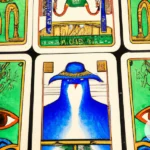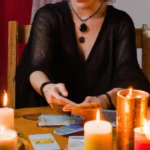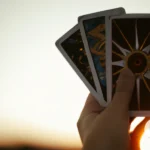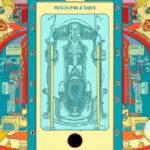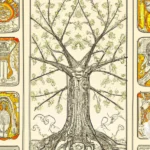Have you ever wondered why Tarot cards have been shrouded in mystery and misconceptions? Many people associate Tarot cards with Satanism, but is there any truth to this belief? In this comprehensive article, we will delve into the history of Tarot cards, their meaning, and how they work. We will also explore the common misconceptions surrounding Tarot card reading and why they are not linked to Satanism. Join us as we uncover the truth and benefits of Tarot card reading.
What are Tarot Cards and their History?
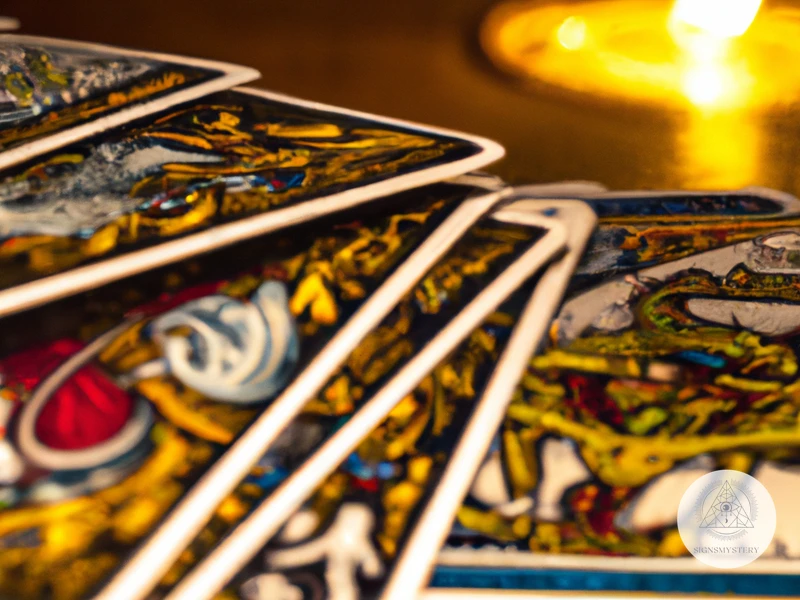
Tarot cards have always invoked mixed reactions from the public, often viewed as tools for divination and fortune-telling. However, the origins and true purpose of tarot cards are shrouded in mystery and misconception. In order to gain a better understanding of the cards and their history, we will delve into their background and design, including the symbols and meanings behind each card. Let’s explore how tarot cards evolved over time and how they transitioned from a simple game to a powerful tool for personal growth and self-awareness. For a deeper insight into the history of tarot cards, check out our article on the history of tarot divination.
1. Brief History of Tarot Cards
Tarot cards have a rich history that dates back to the 14th century. The exact origin of Tarot cards is still a topic of debate, but it is widely believed that the cards were originally designed for playing games such as Tarocchi. Over time, Tarot cards became associated with divination and spiritual practices.
The first known Tarot decks were created in Northern Italy during the Renaissance period. These decks were called “Tarocchi” and were used for playing various card games. The earliest Tarot decks were not designed for divination or fortune-telling purposes.
Tarot cards began to acquire spiritual and mystical symbolism in the 18th and 19th centuries. Famous occultists such as Eliphas Levi and Aleister Crowley popularized the use of Tarot cards for divination and meditation. They believed that Tarot cards contained mystical and symbolic meanings that could help people understand themselves and their place in the universe.
Today, Tarot cards are widely used for divination and spiritual practices. The traditional Tarot deck consists of 78 cards divided into the Major Arcana and Minor Arcana. Each card has a unique meaning and is associated with different symbols and imagery. The Major Arcana cards represent major life events and universal archetypes, while the Minor Arcana cards represent more everyday experiences.
There are many misconceptions about the origins and purpose of Tarot cards. Some people believe that Tarot cards have a direct connection to ancient Egyptian culture, while others think that they are tools of the devil. These stereotypes have been debunked by experts who have studied the history and symbolism of Tarot cards. In reality, Tarot cards are tools that can be used for self-discovery, personal growth, and spiritual development.
Learn More: The Myth of Tarot Cards Being Linked to Ancient Egypt
2. Tarot Card Symbols and Meaning
Tarot cards are known for their distinct symbols and meanings that leave a deep impression on those who choose to delve into their mysteries. Each tarot card contains a unique set of symbols and imagery that is rooted in ancient wisdom and is meant to represent different aspects of the human experience.
Let’s take a closer look at some of the most common symbols in tarot cards and understand their meanings.
The Major Arcana:
| Tarot Card | Symbolism |
|---|---|
| The Fool | New beginnings, risk-taking, innocence |
| The Magician | Manifestation, creation, power |
| The High Priestess | Intuition, secrets, hidden knowledge |
| The Empress | Fertility, nurturing, abundance |
| The Emperor | Authority, structure, stability |
| The Hierophant | Tradition, religion, spirituality |
| The Lovers | Relationships, connection, choices |
The Minor Arcana:
| Tarot Card | Symbolism |
|---|---|
| Ace of Wands | New beginnings, creativity, inspiration |
| Three of Cups | Celebration, community, friendship |
| Seven of Swords | Deception, betrayal, secrecy |
| Ten of Pentacles | Wealth, legacy, inheritance |
| Page of Swords | Cleverness, curiosity, quick thinking |
| King of Cups | Compassion, emotional stability, generosity |
Each tarot card has its own meaning and interpretation that can be influenced by the question being asked or the individual’s personal experiences. It is important to remember that the symbolism in tarot cards is not fixed and can vary depending on the reader’s interpretation.
If you are interested in learning more about the symbols and meanings in tarot cards, check out our article on misunderstandings about tarot cards.
3. How Tarot Cards Work
Tarot cards work by tapping into the subconscious mind and revealing insights and guidance through symbolism and interpretation. When a person consults the tarot, they shuffle and draw cards from a deck of 78 cards, each with its unique image and meaning. The cards are usually divided into two groups- the Major Arcana and Minor Arcana.
The Major Arcana outlines significant life events, spiritual lessons, and transformative experiences. The cards in this group include The Fool, The Magician, The High Priestess, The Empress, The Emperor, The Hierophant, The Lovers, The Chariot, Strength, The Hermit, Wheel of Fortune, Justice, The Hanged Man, Death, Temperance, The Devil, The Tower, The Star, The Moon, The Sun, Judgement, and The World.
On the other hand, The Minor Arcana cards represent the mundane aspects of life and the daily challenges we face. The group includes four suits- cups, pentacles, swords, and wands, each with its unique set of meanings.
When drawing cards, the reader asks a question or thinks of a situation they want guidance on. The tarot cards reflect the energy around the question or situation and the reader interprets the symbolism to provide insight, awareness, and guidance. The interpretation is based on the reader’s intuition, knowledge of the cards, and the person’s unique situation.
It’s essential to note that the cards themselves do not hold any power. Instead, it’s the reader’s interpretation and the person’s ability to integrate the guidance provided that brings about change or clarity in the situation. Tarot cards serve more as a tool for self-discovery and reflection rather than a means of predicting the future.
Debunking the stereotype around tarot can help people see it as a valid tool for self-exploration and personal growth. To understand more about the misconceptions around tarot, check out this article.
Tarot Cards and Satanism: The Connection
The connection between Tarot Cards and Satanism has been a controversial topic among many people for years. While some believe that the use of Tarot Cards is linked to Satan or demonic entities, others argue that it is nothing but a misconception. This section will delve into the origins of this rumor, and explore the differences between Tarot Cards and spiritual practices associated with Satanism. We will also uncover the true purpose of Tarot Cards and what experts in the field have to say about this subject. Join us as we shed light on the misconceptions surrounding Tarot Cards and their supposed connection to Satanism.
1. The Origin of the Rumor
It is perplexing why there is still a persistent rumor that tarot cards are connected to Satanism. Despite numerous sources debunking this claim, many people continue to believe it. The origin of this rumor can be traced back to the 1400s when tarot cards were first created. At the time, the Catholic Church condemned and criticized tarot cards due to their association with divination and occult practices. This furor against tarot cards eventually resulted in the labeling of the cards as “devil’s picture books.”
As the centuries passed, the association between tarot cards and Satanism was further perpetuated by popular culture in both literature and film. The image of a dark, ominous figure shuffling tarot cards only served to reinforce the stigma against tarot cards. Additionally, there have been instances where unscrupulous individuals exploited the mystery and allure of tarot cards for their own financial gain, often giving tarot readings that preyed on people’s fears and worries.
Despite the misconceptions surrounding tarot cards, the truth is that tarot cards were not created for malicious purposes. Rather, they were designed to provide people with a tool for introspection and self-discovery. Tarot cards are not associated with Satanism, and the practitioners who use them do not worship or invoke any dark powers. Rather, they approach tarot cards as a means of gaining insight into their inner selves and finding guidance to make better life decisions.
To truly understand the truth behind tarot cards, it is essential to look past the rumors and misconceptions and delve deeper into their symbolism and meaning. The next section will explore this topic in greater detail.
2. How Satanism is Different from Spiritual Practices
It is essential to understand that Satanism is vastly different from spiritual practices such as tarot card reading. Here are some key differences between the two:
- Satanism is a religion that worships Satan as a deity, while tarot card reading does not involve worshiping any deities or entities. In Satanism, the figure of Satan is revered, and rituals are conducted to honor him. Tarot card reading, on the other hand, is a spiritual practice that involves using cards to gain insight and guidance.
- Satanism involves the use of black magic, while tarot card reading does not. Black magic is the use of supernatural powers for evil and selfish purposes, often for personal gain or to harm others. In contrast, tarot card reading aims to bring clarity, focus, and positivity into one’s life.
- Satanism is often associated with violence and criminal activity, while tarot card reading is not. Satanism has been linked to criminal activities such as animal sacrifice and murder, but there is no evidence that tarot card reading has ever been used for such purposes.
- Satanism is a relatively new religion, while tarot card reading has a long history. Satanism as a formal religion only dates back to the 20th century, while tarot card reading has been around for centuries.
- Satanism promotes selfishness and individualism, while tarot card reading encourages self-reflection and consideration of others. Satanism places emphasis on individual desires and personal success, often to the detriment of others. Tarot card reading, however, reminds us to consider our actions and their impacts on those around us.
By understanding these key differences between Satanism and tarot card reading, it becomes clear that the two practices are not related. It is unfair and inaccurate to label tarot card reading as Satanic, as it does not involve the worship of Satan or the use of black magic.
3. The Truth Behind Tarot Cards and their Purpose
Tarot cards have been subject to misconceptions due to their association with spirituality and occult practices. While there are many myths about the origins, symbols, and purpose of Tarot cards, the truth is that they were created with the intention of providing insight and guidance to those seeking clarity in their lives. Here are some important points to consider regarding Tarot cards and their purpose:
- The Purpose of Tarot Cards: Contrary to popular belief, Tarot cards are not tools for divination or fortune-telling. Instead, they serve as a means of facilitating introspection, self-reflection, and gaining perspective on one’s life. People turn to Tarot cards as a way of gaining insight into the nature of their problems and finding solutions to them.
- The History of Tarot Cards: The origin of Tarot cards is thought to date back to the 14th century in Italy. The first Tarot decks were created as playing cards and didn’t become associated with divination until the late 18th century. Over time, Tarot cards became synonymous with spiritual practices and mysticism. Today, there are hundreds of different Tarot decks available, each with their own unique symbols and meanings.
- The Symbols and Meanings of Tarot Cards: Tarot cards are rich in symbolic imagery, and each card represents a different aspect of human experience. The cards are divided into two categories: the Major Arcana and the Minor Arcana. The Major Arcana cards represent major life events and themes, while the Minor Arcana cards represent everyday situations and challenges. The symbols on the cards are designed to help the reader gain insight into their own life and experiences.
- The Role of the Tarot Reader: Tarot card reading is an art form that requires skill and intuition. A good Tarot reader will not claim to predict the future or provide definitive answers to questions. Instead, they will use the cards as a tool to help the individual gain insight and clarity into their own life. While there are some general interpretations of the cards, the true meaning of each card is subjective and depends on the individual’s unique experiences and perspective.
The purpose of Tarot cards is not to predict the future or engage in satanic practices, but rather to offer insight and guidance through introspection and self-reflection. Tarot cards are a valuable tool for individuals seeking clarity and perspective in their lives, and their use should be approached with an open mind and a willingness to explore the deeper meanings of life’s experiences.
4. What the Experts Say
It is important to look to professionals and experts in the field to understand the truth about the link between tarot cards and Satanism. Many experts in the occult and metaphysical fields have stated that tarot cards have nothing to do with Satanism or evil practices. In fact, renowned tarot card reader Rachel Pollack acknowledges that while some people may associate tarot cards with negative beliefs, the cards themselves are simply a tool to access deeper levels of intuition and understanding.
Additionally, social anthropologist and author Tanya Luhrmann has conducted holistic studies where she explored the practices of people who regularly use tarot cards for divination purposes. Luhrmann found no evidence to support the idea that tarot card readers were influenced by evil forces or had any strong beliefs in Satanism.
Furthermore, Tarot expert and author Mary K. Greer suggests that tarot cards are a way of interpreting the present moment and gaining insight into potential future outcomes. She admits that there may be some historical connection between tarot cards and negative beliefs, but ultimately, she asserts that any harmful beliefs are just misconceptions.
The opinions of experts in the field do not support the link between tarot cards and Satanism. The cards serve a therapeutic and introspective purpose for many individuals, and should not be dismissed as a tool of the devil because of inaccurate assumptions and misunderstandings.
Why Tarot Cards are not linked to Satanism
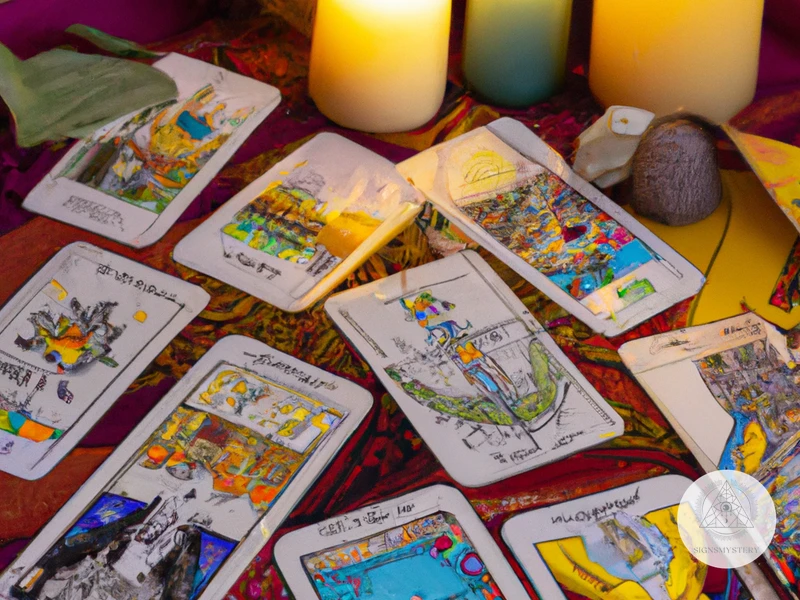
Despite the long-standing association between tarot cards and Satanism, there has been much confusion surrounding this link. However, it is important to understand that tarot cards are not inherently associated with the Christian Satan or any form of devil worship. In fact, renowned practitioners throughout history have used tarot cards as a tool for spiritual and personal growth. By examining the evidence and understanding the true purpose of tarot card reading, it becomes clear that any connection to Satanism is merely a misconception. Let’s explore this further.
1. Tarot Cards are not Associated with the Christian Satan
It is important to understand that Tarot Cards are not associated with the Christian Satan, despite what some may believe. Here are some reasons why:
- The origins of Tarot cards: Tarot cards were first used as playing cards in Europe during the 14th century. They were later used for divination, but the symbols and meanings associated with the cards are not inherently tied to any religious belief system.
- Christianity and the devil: While Christianity does have a concept of Satan, the figure is not present in all religions or belief systems. The use of Tarot cards predates the modern concept of Satan, and therefore cannot be associated with it.
- The purpose of Tarot cards: Tarot cards are used as a tool for self-reflection, self-discovery, and personal growth. They are not used for worshiping or invoking any demonic entity.
Thus, it is clear that Tarot cards have no inherent association with Satan or any other religious belief system. They are simply a tool for introspection and personal growth, with symbols and meanings that are open to interpretation by the individual using them. It is important to approach Tarot card reading with an open mind and to avoid drawing baseless connections to religious beliefs that have no factual basis.
2. The Renowned Practitioners who Used Tarot Cards
Throughout history, many renowned practitioners have used tarot cards for various purposes such as divination, self-reflection, and personal growth. While some may argue that this is an indication of the association between tarot cards and Satanism, it is important to note that these individuals used tarot cards as a tool, which does not necessarily mean they were engaging in any form of dark practice. Let’s take a look at some of the well-known figures who have used tarot cards in their life:
| Practitioner | Field/Profession | Use of Tarot Cards |
|---|---|---|
| Aleister Crowley | Occultist, author, and ceremonial magician | Crowley used tarot cards as a means of divination and spiritual exploration. He also created his own deck known as the Thoth Tarot. |
| C.G. Jung | Psychiatrist and psychoanalyst | Jung used tarot cards as a way to explore the unconscious mind. He believed that the imagery and symbolism of the cards could provide insights into an individual’s psyche. |
| Rachel Pollack | Author, tarot deck creator, and teacher | Pollack has been using tarot cards for over 50 years. She views tarot cards as a tool for self-discovery, creativity, and personal growth. She has also written several books on tarot card reading and interpretation. |
| Salvador Dali | Artist | Dali created his own version of the tarot deck known as the Dali Tarot. He believed that the cards could be used as a method of exploring the subconscious mind and unlocking one’s creativity. |
| Alejandra Pizarnik | Poet and writer | Pizarnik would frequently use tarot cards as a way to spark inspiration for her writing. She found that the images and symbols of the cards would help her access her creativity and express her emotions. |
As we can see, these practitioners come from a range of fields and professions, and they used tarot cards for different reasons. However, what they have in common is the belief that tarot cards can be used as a powerful tool for personal growth, self-discovery, and creative inspiration. It is important to distinguish between the use of tarot cards as a tool for spiritual and personal development, and its portrayal as an object of darkness and Satanism.
3. Tarot Cards and the Quest for Self-Understanding
Tarot cards have been used for centuries as a tool for self-understanding and personal growth. It is a common misconception that tarot cards are used only to predict the future or to communicate with spirits. In reality, tarot cards are a pathway to self-discovery and self-awareness. Through careful meditation and interpretation of the symbols on the cards, one can gain insight into their own thoughts and emotions, and gain a deeper understanding of their own personal journey.
What is self-understanding through tarot cards?
Self-understanding through tarot cards involves a process of introspection and reflection. It requires one to look deeply within themselves and to examine both their conscious and unconscious thoughts and feelings. The symbols on the tarot cards are used as a tool to facilitate this process, as they can serve as a mirror to reflect one’s innermost desires, fears, and hopes.
How does tarot card reading help with self-understanding?
Tarot card reading involves a process of interpretation, where the reader will analyze the symbols and images on each card and interpret their meaning in relation to the question at hand. This process of interpretation can help one develop their intuition and become more aware of their own thoughts and feelings. By using the cards as a tool for reflection, one can gain a deeper understanding of their own personal journey and the issues that may be holding them back.
What are the benefits of self-understanding through tarot cards?
The benefits of self-understanding through tarot cards are numerous. It can help one develop greater self-awareness and self-confidence, as well as gain a deeper understanding of their own relationships, emotions, and motivations. Tarot cards can also be used to provide guidance and support during times of difficulty and uncertainty, helping one make important decisions and find their way through life’s challenges.
Tarot cards are a powerful tool for self-understanding and personal growth. By embracing the symbols and images on the cards and using them as a tool for reflection and introspection, one can gain a deeper understanding of themselves and the world around them, and embark on a journey of self-discovery and personal growth.
Common Misconceptions about Tarot Card Reading
Despite the growing popularity of Tarot Card reading as an instrument for self-discovery and guidance, there continue to be numerous misconceptions and myths surrounding this centuries-old practice. Many people believe that Tarot Cards can predict the future, can be used for evil purposes or are against religious beliefs. However, these assumptions are largely inaccurate and create confusion around the true nature and benefits of Tarot Card reading. In the following section, we will explore and debunk some common misconceptions associated with Tarot Card reading, shedding light on the truth behind this fascinating practice.
1. Misconception: Tarot Cards can Predict the Future
One of the common misconceptions about tarot card reading is that they have the ability to predict the future with certainty. This is far from the truth. While tarot cards can give insights and guidance about a person’s future, they do not provide specific predictions.
Firstly, tarot cards are not magical tools that can foretell the future. Instead, they work on the principle of energy exchange between the reader and the client. The tarot reader’s interpretations of the cards are based on the energy that the client brings to the reading.
It is also important to note that the future is not set in stone – it is constantly changing based on the decisions and actions that people take in the present. Tarot cards can provide guidance on potential future outcomes, but ultimately, it is up to the individual to make their own choices and create
Subscribe to Our Newsletter
Sign up to receive the latest news and updates.
Tarot cards should not be used as a substitute for professional advice. If someone is seeking answers about a specific situation, it is best to consult with a licensed therapist or counselor who can provide reliable advice and support.
It is also worth mentioning that tarot cards cannot predict major life events such as death, illness, or natural disasters. These events are outside of the control of individuals and are not influenced by the cards.
It is important to view tarot cards as a tool for self-reflection and personal growth rather than a means of predicting the future. While they can offer guidance and insights, how an individual responds to these insights determines their future path.
2. Misconception: Tarot Cards Can be Used for Evil Purposes
One of the biggest misconceptions about tarot cards is that they can be used for evil purposes, but this is simply not true. Tarot cards are a tool for self-discovery, personal growth, and spiritual development, not a means of causing harm to others.
Here are some common myths surrounding the idea that tarot cards can be used for evil:
| Myth | Reality |
|---|---|
| Tarot cards can be used to place a curse on someone. | Tarot cards are not capable of causing harm to anyone. They are merely a tool for exploring the inner workings of your mind and emotions, and should be used for personal growth and spiritual development. |
| Tarot cards can be used to control someone’s thoughts or actions. | Again, tarot cards are not capable of controlling anyone’s thoughts or actions. They are simply a way to gain insight into your own inner world. |
| Tarot cards can be used to influence the outcome of a situation. | While tarot cards can provide guidance and insight, they do not have the power to alter the course of events. They are meant to be used as a tool for personal growth and self-discovery, not as a means of manipulating the future. |
It’s important to remember that tarot cards are not inherently good or evil. The meaning behind the cards is largely determined by the person interpreting them. If someone is using tarot cards in a negative or harmful way, it is not the fault of the cards themselves, but rather the intentions and actions of the person using them.
In reality, tarot cards can be an incredibly powerful tool for personal growth and spiritual development. When used with the right intentions and in a positive and empowering way, tarot cards can help you gain a deeper understanding of yourself and the world around you. So, don’t let these common misconceptions hold you back from exploring the transformative power of tarot cards.
3. Misconception: Tarot Cards are Against Religious Beliefs
One of the biggest misconceptions about tarot cards is that they go against religious beliefs. However, this is far from the truth. Tarot cards can be a valuable tool for spiritual exploration and growth. Here are some reasons why this misconception is just that – a misconception:
1. Tarot cards are not tied to any specific religion: Tarot cards are not affiliated with any particular religion or belief system. They are a tool that can be used by people of any faith, or no faith at all.
2. Tarot cards can actually complement religious beliefs: Many people find that tarot cards can enhance their understanding and practice of their religion. Tarot cards can be used to explore spiritual themes and to gain insight into scripture or religious texts.
3. Tarot cards can help deepen one’s spiritual practice: Tarot cards can be used as a tool for personal growth and self-awareness. They can help people reflect on their spiritual journey and deepen their connection to their beliefs.
4. Tarot cards do not worship any gods or deities: The images on tarot cards represent archetypes and universal themes, not specific gods or deities. They do not conflict with religious beliefs that may have a singular god.
5. Many religious leaders and practitioners have used tarot cards: Tarot cards have been used by a diverse range of people, including religious leaders, psychologists, and even Nobel Prize winners. This goes to show that tarot cards can be a valuable tool for anyone seeking to deepen their understanding of themselves and the world around them.
The idea that tarot cards go against religious beliefs is a common misconception. Tarot cards can be a valuable tool for spiritual exploration and growth, and can complement religious beliefs rather than conflicting with them. By using tarot cards responsibly and with an open mind, individuals can deepen their understanding of themselves and their spirituality.
4. Misconception: Only Psychics Can Read Tarot Cards
Another common misconception about tarot card reading is that only psychics have the ability to interpret the messages contained in the cards. This is simply not true. While it is true that some psychics use tarot cards in their readings, anyone can learn to read tarot cards with dedication and practice.
Many tarot card readers do not claim to have any psychic abilities. Instead, they use the cards as a tool to access their intuition and insights into the querent’s life. Interpreting the symbols and meanings of the tarot cards requires a deep understanding of the cards, their meanings, and the way they interact with each other.
To illustrate this point, let’s take a look at the following table:
| Psychic | Non-Psychic |
|---|---|
| May use tarot cards as one of their tools | May also use tarot cards as one of their tools |
| May claim to have psychic abilities | Does not necessarily claim to have psychic abilities |
| May rely more heavily on their intuition | May use more analytical and logical approach |
As we can see from the table, tarot card reading is not exclusive to psychics. In fact, non-psychic readers may approach tarot card reading in a more analytical and logical way, while psychics may rely more heavily on their intuition.
The misconception that only psychics can read tarot cards is unfounded. While some psychic readers do use tarot cards, anyone can learn to read tarot cards with dedication, study and practice. Tarot cards can be an effective and valuable tool for self-discovery, spirituality, decision making, and problem-solving, regardless of whether or not one has psychic abilities.
How Tarot Card Reading Can Benefit You
As misconceptions surrounding tarot card reading begin to unravel, more and more people are discovering the potential benefits of this ancient art form. Whether you are seeking greater self-awareness, emotional healing, or problem-solving skills, tarot cards can provide a unique and powerful tool for personal growth. In this section, we will explore some of the ways in which tarot card reading can benefit you, and shed light on the many ways in which this ancient practice can enhance your life. So, if you have ever been curious about tarot cards and what they can offer, read on to discover the many benefits of this fascinating art form.
1. Self-awareness and Personal Growth
One of the benefits of Tarot Card Reading is the potential for self-awareness and personal growth. Through the images and symbols depicted on the cards, a person can gain insight into their own thoughts, feelings, and behaviors. Here are some ways that Tarot Card Reading can facilitate self-awareness and personal growth:
1. Reflection: When a person receives a Tarot Card reading, they are encouraged to reflect on their own life experiences and how they relate to the cards that are drawn. This reflection can lead to a greater understanding of oneself and one’s life path.
2. Making Connections: Another way that Tarot Card Reading can facilitate self-awareness and personal growth is by helping a person make connections between different areas of their life. The symbols and images on the cards can provide insight into how different aspects of one’s life might be connected and how they impact each other.
3. Identifying Patterns: The patterns that emerge from Tarot Card Readings can also be illuminating. People might notice patterns in relationships, behaviors or decision-making processes that they were not aware of before. This newfound awareness can help a person make positive changes in their life.
4. Challenging One’s Assumptions: Tarot Card Reading can also challenge a person’s assumptions about themselves and the world around them. Sometimes, people are stuck in a particular mindset or belief system, and Tarot Cards can help them see things from a different perspective.
Tarot Card Reading can be a powerful tool for self-awareness and personal growth. By reflecting, making connections, identifying patterns, and challenging assumptions, a person can gain a deeper understanding of themselves, their life journey and purpose, and create positive changes in their life.
2. Emotional Healing and Wellness
Tarot cards are not just mere tools for divination, but they can also be used for emotional healing and wellness. Through tarot reading, one can explore their inner self and gain insights into their emotions, traumas, and blockages. The cards can be used to identify the root cause of emotional pain and help in the process of healing.
Here are some ways in which tarot card reading can benefit emotional healing and wellness:
- Identifying emotional blockages: Tarot cards can identify areas in which an individual may hold emotional blocks. By identifying these blocks, the individual can explore their emotions and work towards releasing them. This can lead to a sense of emotional release and relief.
- Offering clarity: Tarot cards can offer clarity and understanding into the emotions that an individual may be experiencing. Sometimes, it can be difficult to put into words what we are feeling, and tarot can provide the words and insights needed to understand ourselves better.
- Promoting self-reflection: By prompting self-reflection, tarot card reading can help an individual gain a deeper understanding of themselves. This can lead to a greater sense of self-awareness, which is essential for emotional healing.
- Encouraging positive change: Tarot reading can encourage an individual to make positive changes in their life. By identifying areas in which one may need to let go of negativity and embracing positivity, tarot cards can be a catalyst for positive change and emotional healing.
Tarot card reading can be a powerful tool for emotional healing and wellness. Whether you are struggling with emotional trauma or simply looking to gain a deeper understanding of yourself, tarot cards can offer valuable insight and guidance. Through self-reflection and a willingness to let go of negativity, tarot cards can promote positive change in one’s life.
3. Decision-making and Problem-solving
Tarot card readings are not just focused on predicting future events, but they can also be used to gain valuable insight into decision-making and problem-solving. The images and symbols depicted in the cards have a unique way of tapping into our subconscious mind and providing us with valuable insights and suggestions for overcoming challenges.
During a tarot card reading, the cards that are pulled can shed light on a particular situation, providing guidance on which path to take or which decision to make. Tarot readings can help you gain a better understanding of your situation and your own thoughts and feelings towards it. This understanding can help you gain clarity and make more informed decisions.
Through tarot readings, individuals can explore possible outcomes and the different paths they can take. It helps them weigh the risks and benefits of each decision and make an informed choice that aligns with their goals and desires. Tarot cards can offer actionable steps to overcome obstacles that might be blocking their path and guide them to the most efficient and effective way forward.
The table below provides an overview of how tarot cards can help with decision-making and problem-solving:
| Benefits of Tarot Cards in Decision-making and Problem-solving |
|---|
| 1. Gain Insight: Tarot cards can provide insights into situations, decisions, and emotions, helping individuals better understand themselves and their environment. |
| 2. Explore Possibilities: Tarot cards can offer guidance regarding different paths and potential outcomes, providing a new perspective on the situation at hand. |
| 3. Weigh Risks and Benefits: Tarot card readings can help individuals evaluate the pros and cons of each decision and make an informed choice that aligns with their goals. |
| 4. Overcome Obstacles: Tarot cards can provide actionable steps to help individuals overcome obstacles that might be blocking their path towards a particular goal. |
Tarot cards are a powerful tool that can help individuals gain valuable insight into decision-making and problem-solving. By tapping into our subconscious mind and providing us with a new perspective on the situation at hand, we can make more informed choices that align with our goals and desires. Through tarot readings, individuals can explore possibilities, weigh risks and benefits, and overcome any obstacles that might be blocking their path to success.
Conclusion
In conclusion, it is clear that the misconception linking Tarot cards with Satanism is unfounded and misguided. The use of Tarot cards as a tool for self-awareness, personal growth, emotional healing, and problem-solving has been embraced by practitioners from different backgrounds and cultures for centuries. Through an understanding of the origins and symbolism of Tarot cards, it becomes clear that their purpose is not rooted in Satanism or any other form of evil practice.
It is important to debunk the myths and misconceptions surrounding Tarot cards and educate individuals on their true purpose and potential benefits. Tarot cards offer a unique and valuable means of exploring one’s inner self, gaining insight into emotions and behaviors and unlocking new perspectives on life’s challenges.
As with any spiritual or personal growth practice, it is important to approach Tarot card reading with an open mind and a willingness to explore and learn. Whether for self-exploration or guidance in decision-making, Tarot cards can provide a useful tool for anyone seeking to achieve greater emotional and spiritual balance.
In dismissing the baseless claims of their perceived association with Satanism, and embracing the true potential of Tarot cards, individuals can open themselves up to a world of insight and understanding, while exploring new paths to self-awareness and personal growth.
Frequently Asked Questions
What is tarot card reading?
Tarot card reading is a divination practice that uses a deck of tarot cards to gain insight into the past, present, and future.
How accurate are tarot card readings?
The accuracy of a tarot card reading depends on several factors, including the skill of the reader, the interpretation of the cards, and the willingness of the person receiving the reading to engage with the process.
Do tarot cards predict the future?
Tarot cards do not predict the future in a literal sense, but they can provide guidance and insight into possible outcomes based on current circumstances and actions.
Can someone learn to read tarot cards?
Yes, anyone can learn to read tarot cards with dedication, patience, and practice.
Is tarot card reading a form of witchcraft?
No, tarot card reading is not inherently witchcraft or sorcery, as it does not involve performing spells or rituals.
Can tarot cards be used for evil purposes?
Tarot cards are simply a tool and do not have inherent morality or intention. It is ultimately up to the reader and their intentions to determine how they use them.
Do I have to be spiritual or have psychic abilities to use tarot cards?
No, anyone can use tarot cards regardless of their religious beliefs or psychic abilities. Tarot cards are accessible to anyone who is willing to engage with them.
Can tarot card reading help with decision-making?
Yes, tarot card reading can offer perspective and insight into possible outcomes and help with decision-making.
Is it necessary to believe in tarot cards for them to work?
No, it is not necessary to believe in tarot cards for them to provide insight and guidance. It is simply important to approach them with an open mind and willingness to engage with the process.
Do tarot cards have any religious affiliation?
Tarot cards do not have a specific religious affiliation, although they may be used within the context of certain spiritual practices or belief systems.






